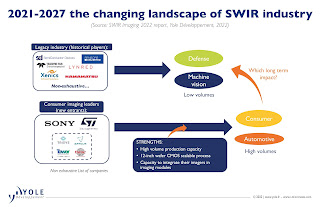Yole Developpement believes that ST and Sony could disrupt the technological landscape with their SWIR imagers:
"In 2021, the SWIR industry’s leading players were SCD, Sensors Unlimited, and Teledyne FLIR, sharing more than 50% of the 11,000 units shipped in the year. These leaders are subsidiaries of leading defense companies that started developing SWIR technology with the support of governments for strategic purposes. They constitute the legacy side of the SWIR industry.
On the other side, STMicroelectronics and Sony, two leaders in the consumer imaging industry started being active players in SWIR with new technologies including quantum dots. Their entrance might be explained by the growing demand from consumer OEM for new integration designs such as under-display 3D sensing in smartphones. If SWIR imagers reach a low price point, shipments could skyrocket to hundreds of millions within a few years. The SWIR industry could emulate the current 3D imaging industry, where STMicroelectronics and Sony share nearly 95% of the 225 million shipments (2020 data)."



sony will capture this much market share with what? i guess the huge volume will not be based on ingaas. st published on cqd, right? so i tend to agree, but with what application? what is the high volume application for swir?
ReplyDeleteYole's answer is right in second picture.
Delete"SWIR may be used in smartphone under-display 3D sensing since OLED displays are more transparent to SWIR wavelengths than the NIR currently used."
How can we deal with the metal layers inside OLED display? OLED material is transparent in SWIR band, but you have a lot of metal structures and even metal refectors behind OLDs and they are not transparent to any optical signals.
Deleteso the prediction is that the mass market for SWIR imaging is enabled by "removing a small gap in the smartphone display" right? do I understand this right: the motivation is to put the camera based biometric id function behind the display? it is not a "technical" issue in the scene like less sunlight interaction, or that it is more eye safe. it is "just" to make this "biometric id" camera invisible behind the display?
ReplyDeleteWe need low cost devices or with expected low cost devices to attract more R&D effort to find applications. If you stay at workshop style fabric with very high price, no one will be interested at all.
Delete